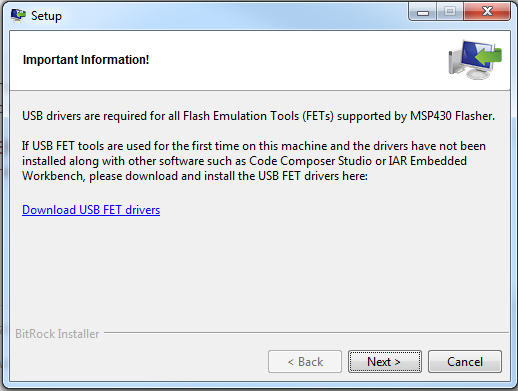SLAU647O July 2015 – April 2020
-
MSP Debuggers
- Trademarks
- 1 Introduction
- 2 MSP Debug Probe Overview
- 3
Hardware Identification
- 3.1 How to Determine If Your Hardware is Based on eZ-FET or eZ-FET Lite
- 3.2 How to Determine If Your Hardware is Based on eZ430
- 3.3 Signal Connections for In-System Programming and Debugging
- 3.4 Using the Power Supply Feature of the eZ-FET and eZ-FET Lite
- 3.5 Using the Power Supply Feature of the MSP-FET430UIF and MSP-FET
- 4 Hardware Installation
- 5
Debug Probes Hardware and Software
- 5.1 MSPDebugStack
- 5.2 Ultra-Low-Power (ULP) Debug Support
- 5.3 EnergyTrace™ Technology
- 5.4 Unlimited Software Breakpoints in Flash, FRAM, and RAM
- 5.5 JTAG Access Protection (Fuse Blow)
- 5.6 MSP-FET Stand-Alone Debug Probe
- 5.7 MSP-FET430UIF Stand-Alone Debugger
- 5.8 eZ-FET and eZ-FET Lite Onboard Emulation
- 5.9 eZ430 Onboard Emulation
- 5.10 MSP-FET430PIF
- Revision History
4.4 Hardware Installation Using the MSP Flasher
MSP Flasher is an open-source shell-based interface for programming any MSP430 MCU through an MSP debug stack and provides the most common functions on the command line. MSP Flasher can be used to download binary files (.txt or .hex) directly to the MSP430 memory without the need for an IDE like CCS or IAR. It can also be used to extract firmware directly from a device, set hardware breakpoints, and lock JTAG access permanently.
MSP Flasher supports the following operating systems:
- Windows 10 32-bit or 64-bit
- Windows 8 32-bit or 64-bit
- Windows 7 32-bit or 64-bit
- Windows XP 32-bit or 64-bit
- Ubuntu™ 64-bit
- OS X 64-bit
Installation steps for the MSP-FET430UIF, MSP-FET, eZ-FET or eZ-FET Lite:
- After successfully downloading and executing the MSP Flasher installer, it prompts you to execute the stand-alone driver installer for the MSP debug probes.
- Follow the steps given by the stand-alone driver installer for debug probe driver installation.
- After successful driver installation, connect the debug probe to a USB port on the PC using the provided USB cable.
- After connecting the debug probe to a PC, it performs a self-test. If the self-test passes, the green LED stays on. For a complete list of LED signals, see the LED Signals section of every debug probe in Section 5.6 through Section 5.8.
- Connect the debug probe with the target board using the 14-pin ribbon cable.
- When using a target socket board, make sure that the MSP430 MCU is properly inserted in the socket and that its pin 1 (indicated with a circular indentation on the top surface) aligns with the "1" mark on the PCB.
 Figure 8. MSP Flasher Driver Install Notification
Figure 8. MSP Flasher Driver Install Notification